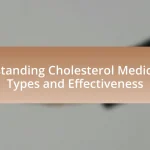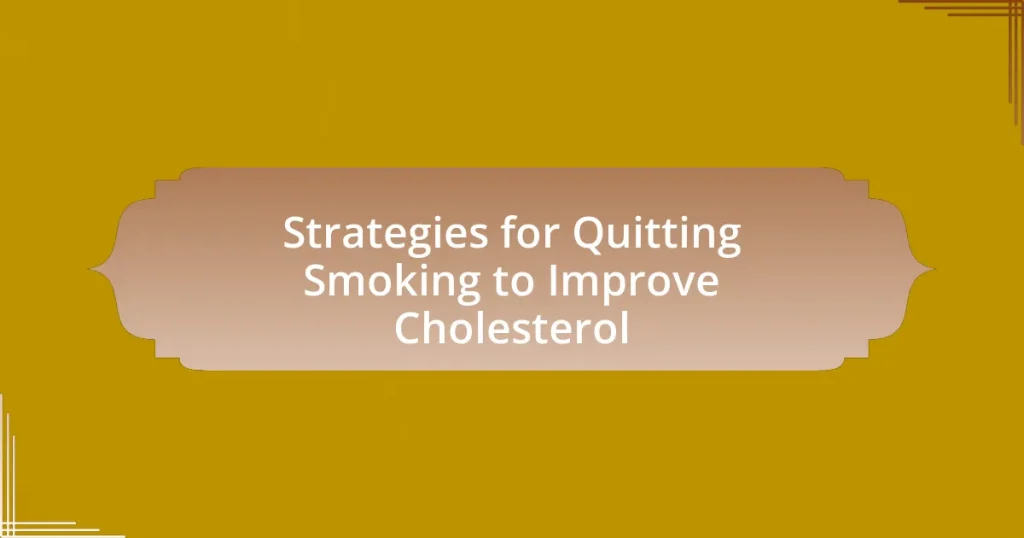The article focuses on effective strategies for quitting smoking to improve cholesterol levels and overall cardiovascular health. It outlines various methods, including nicotine replacement therapies, behavioral counseling, and structured quit plans, which enhance the likelihood of successful cessation. The article also discusses the immediate and long-term impacts of quitting smoking on cholesterol levels, common challenges faced during the quitting process, and the role of psychological factors in smoking addiction. Additionally, it highlights the importance of lifestyle changes, such as diet and exercise, in maintaining cholesterol health post-cessation, as well as the benefits of professional support and resources available for individuals seeking to quit smoking.

What are Effective Strategies for Quitting Smoking to Improve Cholesterol?
Effective strategies for quitting smoking to improve cholesterol include utilizing nicotine replacement therapies, engaging in behavioral counseling, and adopting a structured quit plan. Nicotine replacement therapies, such as patches or gum, help reduce withdrawal symptoms and cravings, making it easier to quit. Behavioral counseling provides support and coping strategies, which can increase the likelihood of successful cessation. A structured quit plan, which may involve setting a quit date and identifying triggers, further enhances the chances of quitting successfully. Research indicates that individuals who use a combination of these strategies are more likely to achieve long-term abstinence from smoking, leading to improved cholesterol levels and overall cardiovascular health.
How does quitting smoking impact cholesterol levels?
Quitting smoking leads to improved cholesterol levels by increasing high-density lipoprotein (HDL) cholesterol, which is known as “good” cholesterol. Research indicates that individuals who stop smoking can experience a rise in HDL levels by approximately 5% to 10% within a year of quitting. This increase in HDL cholesterol is significant because higher levels of HDL are associated with a reduced risk of cardiovascular diseases. Additionally, quitting smoking helps lower low-density lipoprotein (LDL) cholesterol and triglycerides over time, further enhancing overall lipid profiles and promoting better heart health.
What are the immediate effects of quitting smoking on cholesterol?
Quitting smoking leads to immediate improvements in cholesterol levels, particularly an increase in high-density lipoprotein (HDL) cholesterol, which is known as “good” cholesterol. Within just 24 hours of cessation, HDL levels can begin to rise, contributing to better cardiovascular health. Research indicates that former smokers experience a significant reduction in the risk of heart disease as their cholesterol profile improves over time, with studies showing that HDL cholesterol can increase by 5% to 10% within the first year of quitting. This positive change is crucial as higher HDL levels are associated with a lower risk of atherosclerosis and heart-related issues.
How does long-term cessation influence cholesterol health?
Long-term cessation of smoking significantly improves cholesterol health by increasing high-density lipoprotein (HDL) levels and reducing low-density lipoprotein (LDL) levels. Research indicates that former smokers experience a rise in HDL cholesterol, which is beneficial for cardiovascular health, while the harmful LDL cholesterol levels tend to decrease over time. A study published in the Journal of the American College of Cardiology found that individuals who quit smoking had a 5-10% increase in HDL cholesterol within a year of cessation, contributing to a lower risk of heart disease. This evidence supports the conclusion that long-term smoking cessation positively influences cholesterol health.
What are the common challenges faced when quitting smoking?
Common challenges faced when quitting smoking include nicotine withdrawal, cravings, and psychological dependence. Nicotine withdrawal symptoms can manifest as irritability, anxiety, and difficulty concentrating, which occur because the body is adjusting to the absence of nicotine. Cravings for cigarettes can be intense and persistent, often triggered by environmental cues or stress. Additionally, psychological dependence can lead to emotional struggles, as many smokers associate smoking with coping mechanisms for stress or social situations. Research indicates that approximately 70% of smokers want to quit, but only about 6% succeed without assistance, highlighting the difficulty of overcoming these challenges.
What psychological factors contribute to smoking addiction?
Psychological factors that contribute to smoking addiction include stress, anxiety, and social influences. Stress often leads individuals to smoke as a coping mechanism, while anxiety can create a reliance on nicotine for temporary relief. Additionally, social environments that normalize smoking can reinforce the behavior, making it more difficult to quit. Research indicates that approximately 70% of smokers express a desire to quit, yet psychological dependencies often hinder their efforts, demonstrating the significant role these factors play in maintaining addiction.
How can withdrawal symptoms affect the quitting process?
Withdrawal symptoms can significantly hinder the quitting process by causing physical and psychological discomfort that may lead to relapse. These symptoms, which can include irritability, anxiety, cravings, and difficulty concentrating, often create a strong urge to return to smoking as a coping mechanism. Research indicates that approximately 70% of smokers who attempt to quit experience withdrawal symptoms, which can last for weeks and contribute to a high failure rate in cessation attempts. The presence of these symptoms can deter individuals from persisting with their quit attempts, making effective management strategies essential for success.
What resources are available to support quitting smoking?
Resources available to support quitting smoking include counseling services, nicotine replacement therapies, prescription medications, and support groups. Counseling services, such as those provided by the National Cancer Institute, offer personalized strategies and emotional support to help individuals quit. Nicotine replacement therapies, like patches and gum, can reduce withdrawal symptoms and cravings, with studies showing they can double the chances of quitting successfully. Prescription medications, such as varenicline and bupropion, have been clinically proven to aid in smoking cessation by targeting nicotine receptors in the brain. Additionally, support groups, both in-person and online, provide community and encouragement, which are crucial for maintaining motivation during the quitting process.
What role do support groups play in smoking cessation?
Support groups play a crucial role in smoking cessation by providing emotional support, accountability, and shared experiences among individuals trying to quit smoking. These groups foster a sense of community, which can significantly enhance motivation and reduce feelings of isolation during the quitting process. Research indicates that participants in support groups are more likely to remain smoke-free compared to those who attempt to quit alone; for instance, a study published in the journal “Tobacco Control” found that individuals who engaged in group therapy had a 50% higher success rate in quitting smoking than those who did not participate in such groups. This evidence underscores the effectiveness of support groups in facilitating long-term smoking cessation.
How effective are nicotine replacement therapies?
Nicotine replacement therapies (NRTs) are effective in helping individuals quit smoking, with success rates approximately 1.5 to 2 times higher than placebo treatments. Research indicates that NRTs, such as patches, gum, and lozenges, provide a controlled dose of nicotine to reduce withdrawal symptoms and cravings, facilitating the quitting process. A meta-analysis published in the Cochrane Database of Systematic Reviews found that NRTs significantly increase the likelihood of quitting smoking compared to non-pharmacological interventions, with a success rate of about 10-20% over a six-month period.

What Techniques Can Enhance the Success of Quitting Smoking?
Cognitive Behavioral Therapy (CBT) and nicotine replacement therapies (NRT) significantly enhance the success of quitting smoking. CBT helps individuals identify and change negative thought patterns associated with smoking, leading to improved coping strategies and reduced cravings. Studies indicate that CBT can increase the likelihood of quitting by 50% compared to those who do not receive such therapy. NRT, including patches, gum, and lozenges, provides a controlled dose of nicotine to ease withdrawal symptoms, which can double the chances of quitting successfully. Research published in the Journal of the American Medical Association shows that combining NRT with behavioral support increases cessation rates significantly.
How can behavioral strategies aid in quitting smoking?
Behavioral strategies can significantly aid in quitting smoking by addressing the psychological and emotional aspects of addiction. These strategies include techniques such as cognitive-behavioral therapy (CBT), which helps individuals identify and change negative thought patterns associated with smoking. Research indicates that CBT can increase the likelihood of quitting by up to 50% compared to those who do not use such strategies. Additionally, support groups and counseling provide social reinforcement, which has been shown to enhance motivation and accountability, further improving cessation rates.
What are some effective coping mechanisms for cravings?
Effective coping mechanisms for cravings include distraction techniques, mindfulness practices, and physical activity. Distraction techniques, such as engaging in hobbies or socializing, can redirect focus away from cravings. Mindfulness practices, including deep breathing and meditation, help individuals become aware of their cravings without acting on them. Physical activity, like walking or exercising, releases endorphins that can reduce the intensity of cravings. Research indicates that these strategies can significantly lower the likelihood of relapse during smoking cessation efforts, thereby supporting improved cholesterol levels.
How can mindfulness practices support smoking cessation?
Mindfulness practices can support smoking cessation by enhancing self-awareness and reducing cravings. These practices, such as meditation and mindful breathing, help individuals recognize triggers and manage stress without resorting to smoking. Research indicates that mindfulness-based interventions can lead to a significant reduction in smoking rates; for instance, a study published in the journal “Tobacco Control” found that participants who engaged in mindfulness training were more likely to quit smoking compared to those who did not. This evidence underscores the effectiveness of mindfulness in promoting healthier coping mechanisms and ultimately supporting individuals in their journey to quit smoking.
What lifestyle changes can complement quitting smoking?
Regular exercise can significantly complement quitting smoking by improving cardiovascular health and enhancing lung function. Engaging in physical activity, such as aerobic exercises, has been shown to reduce cravings and withdrawal symptoms associated with smoking cessation. According to a study published in the journal “Tobacco Control,” individuals who incorporated regular exercise into their routine experienced higher success rates in quitting smoking compared to those who did not. Additionally, a balanced diet rich in fruits, vegetables, and whole grains can support overall health and help manage weight, which is often a concern for individuals who have quit smoking. Research indicates that a nutritious diet can also improve cholesterol levels, further benefiting cardiovascular health.
How does diet influence cholesterol levels during cessation?
Diet significantly influences cholesterol levels during cessation by affecting lipid metabolism and overall cardiovascular health. A diet high in saturated fats and trans fats can elevate LDL cholesterol levels, while a diet rich in fruits, vegetables, whole grains, and healthy fats, such as omega-3 fatty acids, can help lower LDL cholesterol and raise HDL cholesterol. Research indicates that individuals who adopt a heart-healthy diet during smoking cessation are more likely to experience improved cholesterol profiles, as evidenced by a study published in the Journal of the American College of Cardiology, which found that dietary changes can lead to a 10-15% reduction in LDL cholesterol levels within weeks.
What role does exercise play in improving cholesterol after quitting?
Exercise plays a significant role in improving cholesterol levels after quitting smoking. Engaging in regular physical activity can help raise high-density lipoprotein (HDL) cholesterol, which is known as “good” cholesterol, while simultaneously lowering low-density lipoprotein (LDL) cholesterol, or “bad” cholesterol. Studies indicate that individuals who incorporate exercise into their routine after quitting smoking can experience a notable improvement in their lipid profiles. For instance, a study published in the Journal of the American College of Cardiology found that moderate-intensity exercise can lead to a 5-10% increase in HDL cholesterol levels. This improvement is crucial for reducing the risk of cardiovascular diseases, which is often heightened after quitting smoking.
What are the benefits of professional help in quitting smoking?
Professional help in quitting smoking significantly increases the chances of success compared to self-quit attempts. Research indicates that individuals who seek professional assistance, such as counseling or medication, are up to three times more likely to quit successfully. This is supported by the U.S. Department of Health and Human Services, which states that behavioral therapy and pharmacotherapy can enhance cessation rates. Additionally, professionals provide tailored support, coping strategies, and accountability, which are crucial for overcoming addiction and managing withdrawal symptoms effectively.
How can counseling improve the chances of quitting successfully?
Counseling can significantly improve the chances of quitting smoking successfully by providing personalized support and strategies tailored to individual needs. Research indicates that individuals who engage in counseling are more likely to quit smoking compared to those who do not; for instance, a meta-analysis published in the journal “Tobacco Control” found that behavioral counseling increases the likelihood of quitting by 1.5 to 2 times. Counseling helps individuals identify triggers, develop coping strategies, and maintain motivation, which are critical components in overcoming addiction. Additionally, the support from a counselor can enhance accountability and provide encouragement, further reinforcing the commitment to quit smoking.
What medications are available to assist in smoking cessation?
Medications available to assist in smoking cessation include nicotine replacement therapies (NRTs), bupropion, and varenicline. NRTs, such as patches, gum, lozenges, inhalers, and nasal sprays, provide a controlled dose of nicotine to reduce withdrawal symptoms and cravings. Bupropion, an atypical antidepressant, helps reduce cravings and withdrawal symptoms by affecting neurotransmitters in the brain. Varenicline works by stimulating nicotine receptors in the brain, which reduces withdrawal symptoms and the pleasure associated with smoking. Clinical studies have shown that these medications can significantly increase the chances of successfully quitting smoking, with NRTs and varenicline being particularly effective in various populations.

What Practical Tips Can Help Maintain Cholesterol Health After Quitting Smoking?
To maintain cholesterol health after quitting smoking, individuals should adopt a heart-healthy diet, engage in regular physical activity, and manage stress effectively. A heart-healthy diet includes consuming fruits, vegetables, whole grains, and healthy fats while limiting saturated and trans fats, which can help lower LDL cholesterol levels. Regular physical activity, such as at least 150 minutes of moderate aerobic exercise per week, can improve overall cardiovascular health and raise HDL cholesterol. Additionally, managing stress through techniques like mindfulness or yoga can positively impact cholesterol levels, as stress can lead to unhealthy eating habits and increased cholesterol. These strategies are supported by research indicating that lifestyle changes significantly influence cholesterol levels and overall heart health.
How can individuals monitor their cholesterol levels post-cessation?
Individuals can monitor their cholesterol levels post-cessation by scheduling regular blood tests with a healthcare provider. These tests typically measure total cholesterol, LDL (low-density lipoprotein), HDL (high-density lipoprotein), and triglycerides, providing a comprehensive overview of cholesterol health. According to the American Heart Association, adults should have their cholesterol checked every four to six years, but those with risk factors may need more frequent assessments. Monitoring cholesterol levels helps individuals track improvements in their cardiovascular health after quitting smoking, as studies indicate that cessation can lead to significant reductions in LDL cholesterol and increases in HDL cholesterol over time.
What are the recommended frequency and methods for cholesterol testing?
Cholesterol testing is recommended every 4 to 6 years for adults aged 20 and older, with more frequent testing for individuals at higher risk of heart disease. The primary method for cholesterol testing is a lipid panel, which measures total cholesterol, LDL (low-density lipoprotein), HDL (high-density lipoprotein), and triglycerides. This testing is typically done through a blood sample taken after fasting for 9 to 12 hours, ensuring accurate measurement of lipid levels. Regular monitoring helps in assessing cardiovascular risk and guiding lifestyle changes or treatments.
How can one interpret cholesterol test results effectively?
To interpret cholesterol test results effectively, one should focus on understanding the levels of total cholesterol, LDL (low-density lipoprotein), HDL (high-density lipoprotein), and triglycerides. Total cholesterol should ideally be below 200 mg/dL, LDL should be less than 100 mg/dL for optimal health, HDL should be 60 mg/dL or higher for protective effects, and triglycerides should be below 150 mg/dL. These values are established by the American Heart Association, which indicates that maintaining these levels can significantly reduce the risk of cardiovascular diseases.
What dietary adjustments can support cholesterol improvement?
To improve cholesterol levels, individuals should adopt a diet rich in soluble fiber, healthy fats, and plant sterols. Consuming foods such as oats, beans, lentils, fruits, and vegetables can help lower LDL cholesterol. Research indicates that soluble fiber can reduce cholesterol absorption in the bloodstream, with studies showing that a daily intake of 5 to 10 grams can lower LDL cholesterol by 5% to 10%. Additionally, incorporating sources of healthy fats, like avocados, nuts, and olive oil, can improve overall lipid profiles by increasing HDL cholesterol. Plant sterols, found in fortified foods, can also lower cholesterol levels by blocking its absorption in the intestines, with a daily intake of about 2 grams shown to reduce LDL cholesterol by 5% to 15%.
Which foods should be included in a cholesterol-friendly diet?
A cholesterol-friendly diet should include foods high in soluble fiber, healthy fats, and plant sterols. Foods such as oats, barley, beans, lentils, fruits like apples and citrus, vegetables, nuts, and fatty fish are beneficial. Soluble fiber helps reduce cholesterol absorption, while healthy fats from sources like avocados and olive oil can improve heart health. Additionally, plant sterols found in fortified foods can lower LDL cholesterol levels. Research indicates that incorporating these foods can significantly impact cholesterol levels and overall cardiovascular health.
What are the foods to avoid for better cholesterol management?
To manage cholesterol effectively, individuals should avoid foods high in saturated fats, trans fats, and cholesterol. Saturated fats are commonly found in red meat, full-fat dairy products, and certain oils like palm and coconut oil, which can raise LDL cholesterol levels. Trans fats, often present in processed foods, baked goods, and margarine, are particularly harmful as they not only increase LDL cholesterol but also lower HDL cholesterol. Additionally, foods high in dietary cholesterol, such as organ meats, shellfish, and egg yolks, should be limited, as they can contribute to elevated cholesterol levels in some individuals. Studies indicate that reducing these types of foods can lead to improved cholesterol profiles and overall heart health.
What are some best practices for sustaining a smoke-free lifestyle?
To sustain a smoke-free lifestyle, individuals should implement strategies such as setting clear goals, seeking support from friends and family, and engaging in regular physical activity. Setting specific, measurable goals helps maintain focus and motivation, while social support provides encouragement and accountability. Research indicates that individuals who participate in support groups or counseling are more likely to remain smoke-free; for instance, a study published in the Journal of Substance Abuse Treatment found that support significantly increases the likelihood of quitting successfully. Additionally, regular physical activity not only distracts from cravings but also improves overall health, which is crucial for those looking to enhance their cholesterol levels after quitting smoking.
How can setting goals aid in maintaining a smoke-free life?
Setting goals aids in maintaining a smoke-free life by providing clear targets and motivation for individuals to stay committed to their decision to quit smoking. Specific, measurable, achievable, relevant, and time-bound (SMART) goals help individuals track their progress and celebrate milestones, reinforcing their determination. Research indicates that individuals who set concrete goals are more likely to succeed in quitting smoking; for instance, a study published in the journal “Tobacco Control” found that participants who set specific quit dates and outlined their strategies were significantly more successful in remaining smoke-free compared to those without defined goals.
What strategies can help prevent relapse into smoking?
Effective strategies to prevent relapse into smoking include developing a strong support system, utilizing behavioral therapy, and employing nicotine replacement therapies. A strong support system, such as friends, family, or support groups, can provide encouragement and accountability, which are crucial for maintaining abstinence. Behavioral therapy helps individuals identify triggers and develop coping mechanisms, significantly reducing the likelihood of relapse. Additionally, nicotine replacement therapies, such as patches or gum, can alleviate withdrawal symptoms and cravings, making it easier to stay smoke-free. Research indicates that individuals who engage in these strategies are more likely to remain smoke-free long-term, with studies showing that behavioral therapy combined with support can increase success rates by up to 50%.










